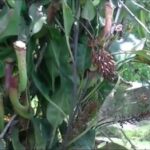As an Amazon Associate, this site earns commissions from qualifying purchases. For more details, click here.
A result of n. maxima and n. northiana, nepenthes Miranda is known for its colorful, 15 inch pitchers. These tropical pitcher plants also produce yellow brown flowers and are ideal for beginners because they grow easily. If you want to try your hand with carnivorous plants, n. Miranda is a very good place to start.
Nepenthes Miranda requires medium to high humidity and 60-85 F in the daytime. These plants must be grown in full, indirect light and in peat soil. Nepenthes Miranda blooms all year and does not go dormant.
Nepenthes Miranda Care Sheet
| Soil | Sphagnum moss, standard pitcher plant soil mixes |
| Water | Only pure water, reverse osmosis, rainwater |
| Light | Full, indirect light 6-8 hours, grow lights may be used |
| Food | Freeze dried worms, fish food, small insects |
| Temperature | 70-85 F (20-30 C) |
| Humidity | 60-100% |
| Dormancy | Not required |
| Propagation | Stem cuttings |
Soil
Nepenthes Miranda prefers neutral to slightly acidic substrates like peat. Do not add fertilizer or compost to the soil. Just keep it moist and allow water to drain.
All pitcher plants including nepenthes Bloody Mary and other popular hybrids, only grow in poor soil. These plants still need nitrogen and other elements so they developed traps to catch nutrient rich insects.
Adding fertilizer to the soil weakens n. Miranda and could even be fatal. If you buy it potted you will see that its soil mixture contains any combination of peat, perlite, vermiculite, silica sand or sphagnum moss. Any number of those are almost always present in nepenthes soil mixes. If you want to prepare your own soil, use a 1:1 ratio.
Pot Container
A 5 inch pot or hanging basket is recommended for nepenthes Miranda. Its pitchers can reach 12—15 inches and the leaves 7-8 inches / 20 cm in diameter. Healthy plants can grow even larger so some space is needed. Nepenthes Miranda is not choosy about pot material. As long as the container is spacious and deep enough, it will do.
Some prefer to hang pitcher plants to regular pots. No matter which you choose, make sure there is space and light available. If you have several nepenthes plants, arrange them so each one gets sufficient light, ventilation, access to prey etc.
A healthy nepenthes Miranda should be repotted every two years. Repot sooner if the plant is showing signs of weakness, insect infestation, signs of root rot etc.
Water
Whether you hang tropical pitcher plants or place it on a windowsill, the watering process is usually the same. This is true for the popular variants including this one.
Nepenthes Miranda needs moist but not waterlogged soil. Use only purified or distilled water and spray freely all over its leaves. Do not fill its pitchers with liquid. Do not use the tray method unless it is scorching hot.
While n. Miranda needs a lot of water, the tray method might be too much. Moist soil is a must for this plant, but too much could cause serious damage.
As long as the temperature is within the ideal range, you should water from the top with a spray bottle. That should be enough to keep the plant healthy.
You may use the tray method if the temperature is always around 90 degrees and up. Pour an inch of water in the container and let the pot sit in it. If the plant responds well, continue it.
Light
Nepenthes Miranda requires full, indirect light. Do not expose the plant directly to the sun, but do not completely cover it either. You can also use artificial lights like Esbaybulbs Lights for indoor cultivation.
If your nepenthes is on a hanging basket outdoors, look for a brightly lit spot. Do not place the basket under the sun but somewhere the light can still reach it.
Do the same with potted plants. Find a spot with full but indirect light. Usually the best place is a windowsill, preferably facing south.
If you are using grow lights, follow the setup instructions. Leave the light on 10-14 hours a day if you are substituting it for natural light.
Whether you opt for natural or artificial light, always make sure the plant is never exposed directly to the source. Doing so could result in overheating and literally burn its leaves and pitchers. Move the plant under shade if you notice dry, empty pitchers or cracked leaves.
Temperature
Nepenthes Miranda grows best in 70-85 F (20-30 C). At night the plant can tolerate cold down to 50 F (10 C).
This plant is tropical and cannot survive freeze. If you live in a warm zone this will do great as an outdoor plant. If you live in a cold area, it is best to cultivate n. Miranda and other tropical pitcher plants indoors.
If your plant is healthy enough it might survive in colder or hotter temperature. And there will probably be times when the temperature in your area is higher than 85 or lower than 70.
Your nepenthes should be fine provided it is only for short periods. However, prolonged exposure to excessive heat and cold will cause problems.
To make things simple, you can grow n. Miranda and other tropical pitcher plants outdoors if the temperature is usually 70-85 degrees. If you get that kind of weather all year around, these plants will grow healthy.
If you have warm summers but cold winters, you have to move the plant indoors during winter. If it rarely gets to 70 even in summer, keep the plant indoors or in a greenhouse or terrarium.
Humidity
One of the things you will learn about nepenthes is most of them grow in warm and humid environments. This combination is ideal for growth, production of nectar and pitcher liquids.
Nepenthes Miranda requires 60-100% humidity. The higher the humidity, the more nectar it can produce to lure prey.
If humidity is lacking, its leaves will dry up and the plant would require more water. Lack of water vapor can imperil growth and affect other vital functions.
If there is not enough moisture in the air, a humidifier can help. You can also water the plant or even use the tray method.
How long nepenthes lives depends on many factors and humidity is one of them. As long you keep the level within the given range, you can expect the plant to remain healthy.
Nutrition and Feeding
One of the things that worries indoor pitcher plant growers is nutrition. Is your n. Miranda going to survive indoors, given that it has limited access to insects? The answer is yes, your nepenthes will be fine.
Nepenthes Miranda has a low nutrient requirement. You can feed it one or two bugs every two weeks and that will be enough. Fish food and mealworms also provides them with nourishment. A nice option is Tetra Gold Fish Flakes because it contains nutrients the plant needs.
Pitcher plants do not necessarily need to eat insects. They make their own food through photosynthesis. But these nutrients provide extra benefits that helps with their development.
And if you do not want to deal with live or dead bugs, freeze worms are acceptable. Just drop the food into one of its pitchers and the plant will use its digestive enzymes to dissolve the food and absorb its nutrients. Of course none of this will be necessary for outdoor nepenthes. You just need to water it and the plant will catch prey on its own.
Dormancy
Nepenthes Miranda is fully tropical and does not go dormant. It requires the same temperature all year around to survive.
Like other tropical pitcher plants, n. Miranda grows flowers all year and feeds on prey regularly. This is only possible though if the environment is conducive to growth.
As noted earlier, n. Miranda prefers a warm, humid location and it cannot handle freezing. If you want to grow this plant in a cold region, you have to do it indoors.
If you grow nepenthes outdoors in summer and move it indoors during winter, make sure you have the proper setup. That is, a light source, heat source, humidifier, water, food etc.
Since the plant is always blooming you can repot and prune it anytime. But most people do it at early spring, the same time as plants that are just emerging from dormancy. However this is not necessary and you can prune and propagate whenever you want.

My fascination with carnivorous plants began many, many years ago with Venus Fly Traps. Now I am more than happy to impart what I know with other enthusiasts and those who are curious about meat eating plants.



